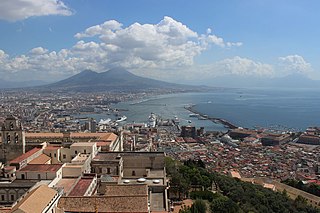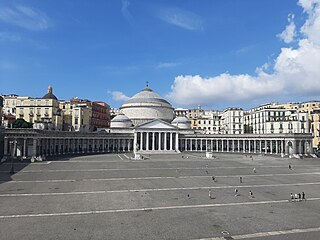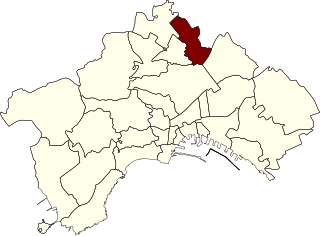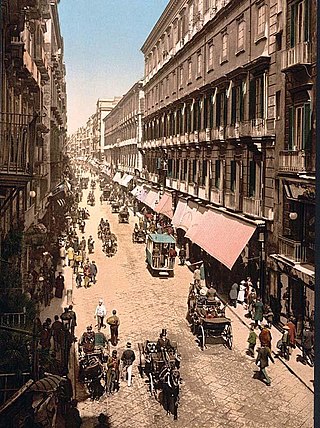This article needs additional citations for verification .(November 2024) |


San Ferdinando is a southern district of Naples, with a population of about 18,000. [1]
This article needs additional citations for verification .(November 2024) |


San Ferdinando is a southern district of Naples, with a population of about 18,000. [1]
San Ferdinando district includes, among the various landmarks, the Royal Palace, Piazza del Plebiscito (the most celebrated square of Naples [2] ), the San Carlo opera house and the church of San Ferdinando, from which the district is named.
The district began to develop during the 16th century, when the Spanish built a first Viceroy's palace, then replaced by the new Royal Palace of Naples by Domenico Fontana. In the following decades, the district became the most desired area of Naples by the city aristocracy because of its proximity to the court, and subsequently many villas and palaces were edified there.

Naples is the regional capital of Campania and the third-largest city of Italy, after Rome and Milan, with a population of 909,048 within the city's administrative limits as of 2022. Its province-level municipality is the third-most populous metropolitan city in Italy with a population of 3,115,320 residents, and its metropolitan area stretches beyond the boundaries of the city wall for approximately 30 kilometres. Naples plays also a key international role in international diplomacy, since it is home to NATO's Allied Joint Force Command Naples and of the Parliamentary Assembly of the Mediterranean.

The Royal Palace of Caserta is a former royal residence in Caserta, Campania, 35km north of Naples in southern Italy, constructed by the House of Bourbon-Two Sicilies as their main residence as kings of Naples. Located 35 km north of the historic centre of Naples, Italy, the complex is the largest palace erected in Europe during the 18th century. In 1997, the palace was designated a UNESCO World Heritage Site; its nomination described it as "the swan song of the spectacular art of the Baroque, from which it adopted all the features needed to create the illusions of multidirectional space". The Royal Palace of Caserta is the largest former royal residence in the world, over 2 million m3 in volume and covering an area of 47,000 m2 and a floorspace of 138,000 square metres is distributed in the five stories of the building.

Piazza del Duomo is the main piazza of Milan, Italy. It is named after, and dominated by, Milan Cathedral. The piazza marks the center of the city, both in a geographic sense and because of its importance from an artistic, cultural, and social point of view. Rectangular in shape, with an overall area of 17,000 m2, the piazza includes some of the most important buildings of Milan, as well some of the most prestigious commercial activities, and it is by far the foremost tourist attraction of the city.

Caserta is the capital of the province of Caserta in the Campania region of Italy. An important agricultural, commercial, and industrial comune and city, Caserta is located 36 kilometres north of Naples on the edge of the Campanian plain at the foot of the Campanian Subapennine mountain range. The city is best known for the 18th-century Bourbon Royal Palace of Caserta.

Piazza del Plebiscito is a large public square in central Naples, Italy.

Vomero is a bustling hilltop district of metropolitan Naples, Italy — comprising approximately two square kilometres (0.77 sq mi) and a population of 48,000.

Ferdinando Fuga was an Italian architect who was born in Florence, and is known for his work in Rome and Naples. Much of his early work was in Rome, notably, the Palazzo della Consulta (1732–7) at the Quirinal, the Palazzo Corsini (1736–54), the façade of the Santa Maria Maggiore (1741–3), and the Church of Sant'Apollinare (1742–8). He later moved to Naples and notably designed the Albergo de'Poveri (1751–81), the façade of the Church of the Gerolamini, and that of the Palazzo Giordano.

Castel Nuovo, often called Maschio Angioino, is a medieval castle located in front of Piazza Municipio and the city hall in central Naples, Campania, Italy. Its scenic location and imposing size makes the castle, first erected in 1279, one of the main architectural landmarks of the city. It was a royal seat for kings of Naples, Aragon and Spain until 1815.

The Royal Palace of Naples is a historic building located in Piazza del Plebiscito, in the historic center of Naples, Italy. Although the main entrance is located in this square, there are other accesses to the complex, which also includes the gardens and the Teatro di San Carlo, from the Piazza Trieste e Trento, Piazza del Municipio and Via Acton.

San Francesco di Paola is a prominent church located to the west in Piazza del Plebiscito, the main square of Naples, Italy. The construction started in 1816 and ended in 1846.

San Carlo all'Arena is a district of Naples, the regional capital of Campania, located north-east of the historic centre of the city. This quarter (quartiere) is named after the Church of San Carlo all'Arena and it constitutes - together with district Stella - Naples' third municipality. The district is centered on the Bourbon Hospice for the Poor located in Piazza Carlo III, a square named after Charles III the first Bourbon king of Naples.

Secondigliano is a modern suburb in the north of Naples, Campania, Italy. It is part of the 7th municipality of Naples, along with the suburbs of Miano and San Pietro a Patierno.
Naples is Italy's fourth largest city in terms of economic size, coming after Milan and Rome and Turin. It is the world's 105th richest city by purchasing power, with a GDP of $69 billion. The economy of Naples and its surrounding area is based largely on tourism, commerce, industry and agriculture. Naples also acts as a busy cargo terminal and the port of Naples is one of the Mediterranean's biggest and most important. The city has had remarkable economic growth since World War II, and unemployment in the wider region has fallen dramatically since 1999. Naples was once a busy industrial city though many factories have shut down in the last decades.

Via Toledo is an ancient street and one of the most important shopping thoroughfares in the city of Naples, Italy. The street is almost 1.2 kilometres (0.75 mi) long and starts at Piazza Dante and ends in Piazza Trieste e Trento, near Piazza del Plebiscito.

The Fontana del Gigante or Fountain of the Giant is a 17th-century fountain monument in Naples.

Chiaia – Monte di Dio is an underground metro station that serves Line 6 on the Naples Metro. The station, designed by the architect Hubert Siola, serve a wide area around the hill Pizzafalcone, on the border between the districts Chiaia and San Ferdinando.

The Caffè Gambrinus is a historic, private cafe or coffeehouse in Central Naples, Italy on via Chiaia. It is located in the rear of the Palazzo della Prefettura, which lies in front and to side of the Royal Palace of Naples, both of which face the Piazza del Plebiscito. The name Gambrinus is a legendary somewhat tipsy figure of joviality, and his name is used for various brands and many establishments.

The Fontana del Carciofo or Fountain of the Artichoke is a monumental public fountain in central Naples, located in Piazza Trieste e Trento, just adjacent to the Piazza del Plebiscito. In the 1950s, plans were made to move the historic Fountain of Monteoliveto depicting the Spanish King to this site. However opposition to the move by the Consiglio Superiore delle Belle Arti, led the city to install this modern fountain featuring a vegetable instead and it was inaugurated in 1956. The area is maintained by the adjacent Caffe Gambrinus. The Church of San Ferdinando faces the piazza.
{{cite web}}: External link in |website=